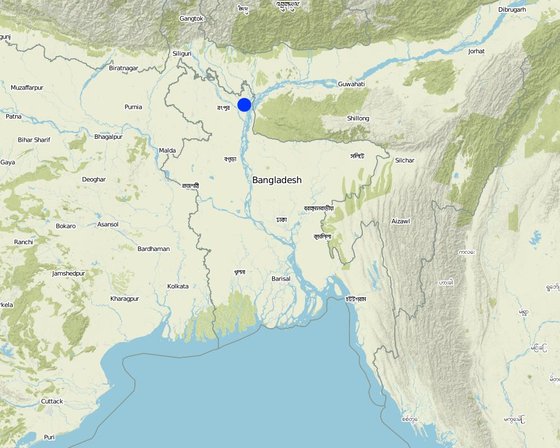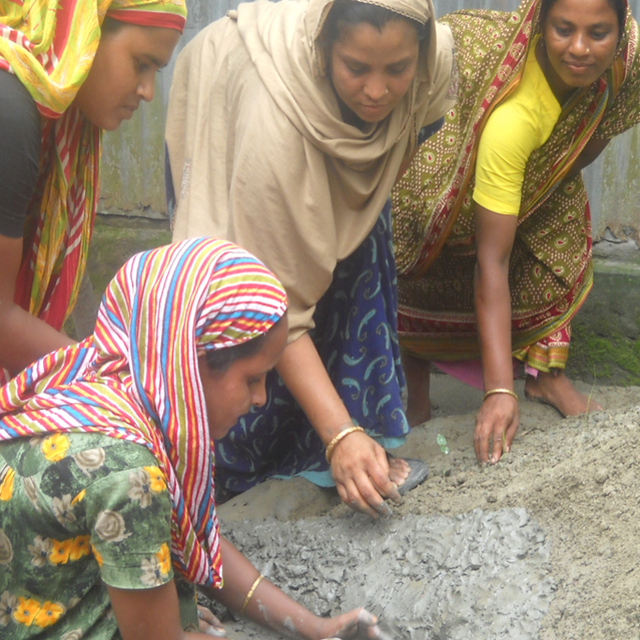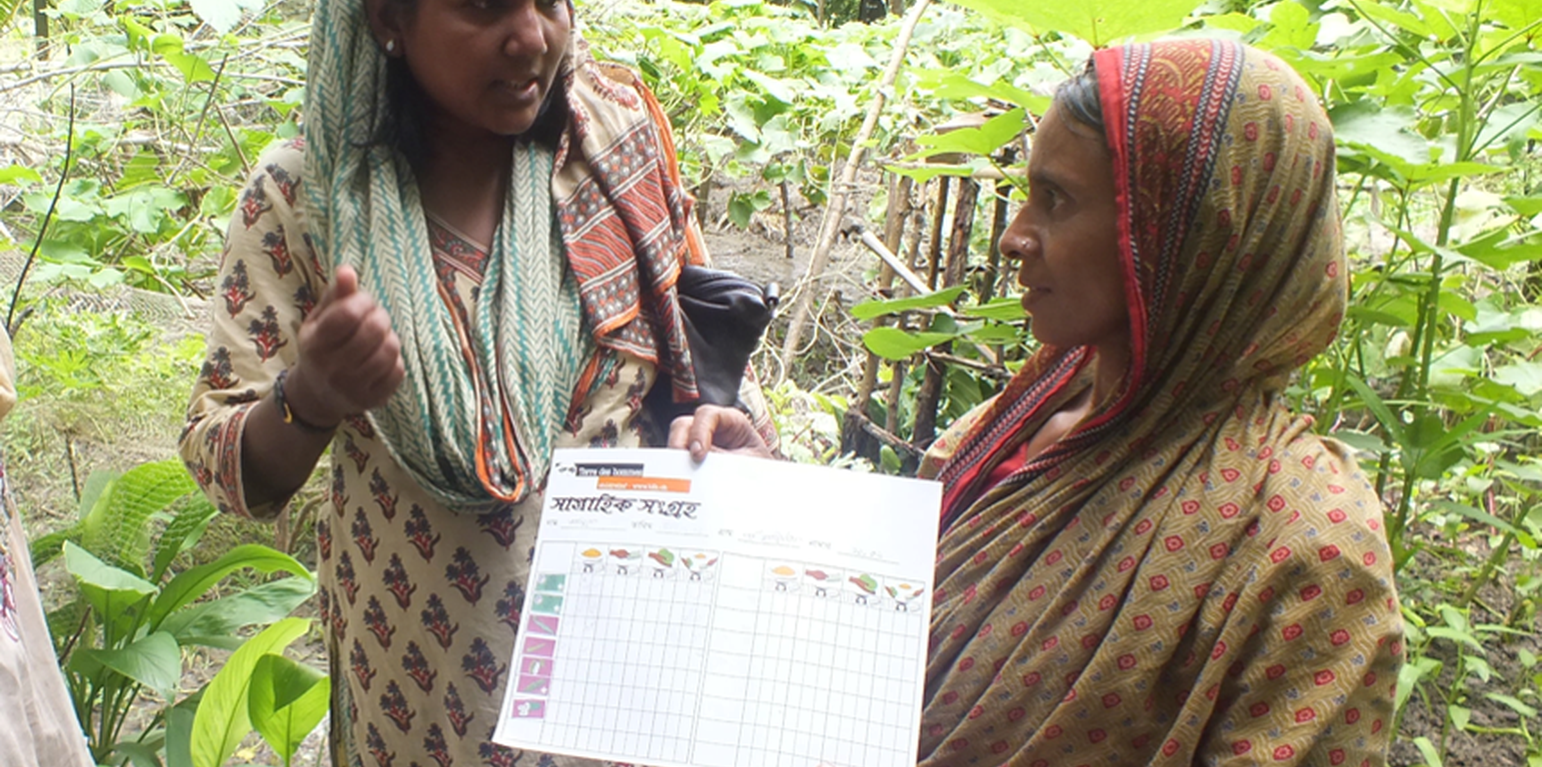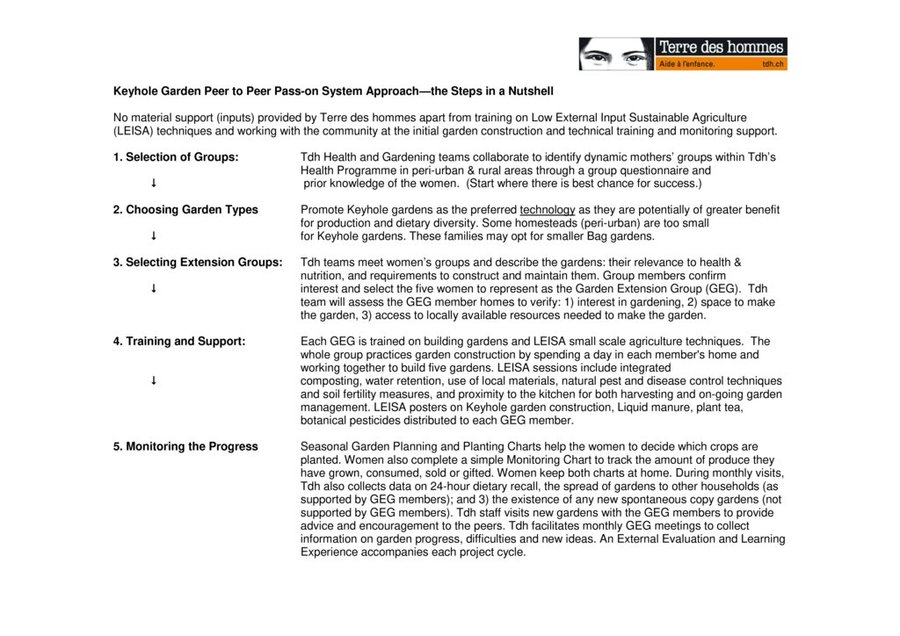Peer to Peer Pass-on Approach with Women
(Bangladesh)
Description
Terre des hommes and Greendots introduced the Peer to Peer pass-on system to enable women's groups in Bangladesh to spread the Keyhole Garden technique within their communities with the aim of enabling year-round homestead vegetable production despite the risk of flooding and tidal surge.
Keyhole Gardens, a type of small, productive homestead vegetable garden based on Low External Input Sustainable Agriculture (LEISA) techniques, have been used in various African countries for over 15 years and shown to increase the availability of food and dietary diversity (FAO). They were developed by gardeners and small-scale farmers (with the support of Send a Cow UK) to suit different situations, such as the cold, dry winters of Lesotho, the small backyards of Rwanda, and the humid heat of central Uganda. To improve year-round homestead nutritional self-sufficiency for vulnerable families in South Asia (where rates of acute malnutrition in young children regularly cross emergency thresholds), Keyhole gardens were adapted by Terre des hommes (Tdh) and Greendots to the conditions of river basin and coastal areas of Bangladesh (and eventually to India's Sundarbuns) . As a component to Tdh's maternal neonatal and child health (MNCH) programme, the technology is intended to support year-round homestead gardening despite weather extremes (flooding, tidal surge, cyclones).
To promote spontaneous replication of the Keyhole gardening in the local communities, the programme initiated a Peer to Peer Pass-on system within 40 mothers' groups (having a total membership of nearly 800 women). Each mothers' group selected five representatives (200 women) to form a Garden Extension Group (GEG) and participate in the first round of training with the understanding that they would share knowledge with other women in the MNCH programme and the surrounding community. The project team trained each GEG on building gardens and LEISA small scale agriculture techniques (including integrated composting, water retention, use of local materials, natural pest and disease control techniques and soil fertility measures, proximity to the kitchen for optimal management and harvesting). GEG group members practiced garden construction by working together to build gardens at the homes of all five members. All 200 initial gardens were monitored by Tdh extension workers on a weekly basis. Tdh verified output, use and the capacity of gardens to withstand monsoon conditions, and the extent of the of the Peer to Peer Pass-on experience.
See the Chart in Section 3.3 for more information.
Location

Location: Kurigram municipality (Kurigram District), Patharghata Union (Barguna District), Kurigram District / Rajshahi Division and Barguna District / Barisal Division, Bangladesh
Geo-reference of selected sites
Initiation date: 2012
Year of termination: n.a.
Type of Approach
-
traditional/ indigenous
-
recent local initiative/ innovative
-
project/ programme based

Practicing together building a Keyhole Garden (Peer to Peer Pass-on system) (S Taylor)
Approach aims and enabling environment
Main aims / objectives of the approach
The main aims of the approach are to involve women by building their capacity and peer network to replicate the Keyhole gardening approach within their communities.
The main objective of the approach is that that families, led by women 1) garden year-round with LEISA techniques, 2) increase the quantity and diversity of their homestead vegetable production and 3) verify that the DRR garden design reduces the consequences of flooding and tidal surge.
Conditions enabling the implementation of the Technology/ ies applied under the Approach
-
Social/ cultural/ religious norms and values: Acceptance of women's groups, existing mothers' groups within Health programme
-
Knowledge about SLM, access to technical support: The Approach calls for capacity building on LEISA techniques (knowledge on SLM) via the Peer to Peer Pass-on system to spread the DRR-designed gardens.
Conditions hindering the implementation of the Technology/ ies applied under the Approach
Participation and roles of stakeholders involved
Stakeholders involved in the Approach and their roles
| What stakeholders / implementing bodies were involved in the Approach? |
Specify stakeholders |
Describe roles of stakeholders |
| local land users/ local communities |
Homestead land users (women) |
Building the gardens: learning and eventually training their peers |
| community-based organizations |
Mothers' groups |
Garden extension groups to share the Keyhole Garden techniques within the scope of their maternal neonatal & child health & activities |
| SLM specialists/ agricultural advisers |
Greendots (www.greendots.ch) |
Technical support with design of the approach: Daniel Varadi and Sheila Taylor. |
| international organization |
Terre des hommes (international NGO) |
Project implementing Agency, direct connection with women's groups within its MNCH Programme via Dr. Sultana Al-Amin (Gardening Specialist). |
Lead agency
Terre des hommes
Involvement of local land users/ local communities in the different phases of the Approach
none
passive
external support
interactive
self-mobilization
initiation/ motivation
Terre des hommes and Greendots working through existing women's MNCH nutrition groups, requested groups to nominate five women to receive the training.
planning
As with all village-level activities, Terre des hommes works with a community volunteer in each village to plan the training and group interventions.
implementation
Once the women were trained, they were free to honor their commitments to train other women.
monitoring/ evaluation
Self planning and monitoring tools were introduced to the women--who decided whether to use them. Tdh provided monthly support visits to help interested women to update the planning and monitoring documents as needed, and to collect data.
Decision-making on the selection of SLM Technology
Decisions were taken by
-
land users alone (self-initiative)
-
mainly land users, supported by SLM specialists
-
all relevant actors, as part of a participatory approach
-
mainly SLM specialists, following consultation with land users
-
SLM specialists alone
-
politicians/ leaders
Decisions were made based on
-
evaluation of well-documented SLM knowledge (evidence-based decision-making)
-
research findings
-
personal experience and opinions (undocumented)
Technical support, capacity building, and knowledge management
The following activities or services have been part of the approach
-
Capacity building/ training
-
Advisory service
-
Institution strengthening (organizational development)
-
Monitoring and evaluation
-
Research
Capacity building/ training
Training was provided to the following stakeholders
-
land users
-
field staff/ advisers
Form of training
-
on-the-job
-
farmer-to-farmer
-
demonstration areas
-
public meetings
-
courses
Advisory service
Advisory service was provided
-
on land users' fields
-
at permanent centres
Monitoring and evaluation
Financing and external material support
Annual budget in USD for the SLM component
-
< 2,000
-
2,000-10,000
-
10,000-100,000
-
100,000-1,000,000
-
> 1,000,000
Precise annual budget: n.a.
The following services or incentives have been provided to land users
-
Financial/ material support provided to land users
-
Subsidies for specific inputs
-
Credit
-
Other incentives or instruments
Impact analysis and concluding statements
Impacts of the Approach
No
Yes, little
Yes, moderately
Yes, greatly
Did the Approach empower local land users, improve stakeholder participation?
Did the Approach help land users to implement and maintain SLM Technologies?
Did the Approach improve coordination and cost-effective implementation of SLM?
Did the Approach improve knowledge and capacities of land users to implement SLM?
Did the Approach empower socially and economically disadvantaged groups?
Did the Approach improve gender equality and empower women and girls?
Did the Approach lead to improved food security/ improved nutrition?
Did the Approach improve the capacity of the land users to adapt to climate changes/ extremes and mitigate climate related disasters?
Main motivation of land users to implement SLM
-
increased production
-
increased profit(ability), improved cost-benefit-ratio
-
reduced land degradation
-
reduced risk of disasters
-
reduced workload
-
payments/ subsidies
-
rules and regulations (fines)/ enforcement
-
prestige, social pressure/ social cohesion
-
affiliation to movement/ project/ group/ networks
-
environmental consciousness
-
customs and beliefs, morals
-
enhanced SLM knowledge and skills
-
aesthetic improvement
-
conflict mitigation
Sustainability of Approach activities
Can the land users sustain what hat been implemented through the Approach (without external support)?
The gardens have no physical inputs from Tdh, and require low external inputs required from families thanks to use of local natural resources. The ‘Farmer to farmer’ or peer to peer pass on learning system is the preferred method for dissemination, and favors group learning and working on the garden planning, monitoring, construction and maintenance together. Once initiated during a project cycle, does not require resources to continue. The diversity of vegetables decreases risk of total crop losses, increases opportunities for nutritional optimization and decreased risk of recurrent malnutrition. Finally, the use of local seed banks, homestead seed production and seed sharing promotes crop genetic diversity.
One woman described how a neighbour has asked her to help build a Keyhole Garden; over the 4 to 5 months she has had it, two to three neighbours have expressed serious interest in the garden. Garden management requires weeding and other work; and because Tdh gives low support she is doing it for herself.
Conclusions and lessons learnt
Strengths: land user's view
-
Those who pass on their vegetables and skills are sometimes invited to share positive testimonials and participate in official events to further share the techniques
-
Skills and knowledge can be passed on not only to other women/farmers but also to local school students—who can pass on new skills to their parents.
-
One Send a Cow UK beneficiary described her happiness about being part of the “chain of giving” in her community.
Strengths: compiler’s or other key resource person’s view
-
The underpinning ethos of this nutrition/gardening project is that it is developed and implemented using participatory processes.
-
Beyond dissemination of technology, peer farmers have a bigger emphasis on support and understanding principles of the different practices since the focus is on two-way communication.
-
Local champions of the pass-on approach have returned to support implementing partner staff through training and extension work in other communities.
-
Passing on can also help restore dignity and pride in smallholder farming communities--and strengthen the social fabric.
Weaknesses/ disadvantages/ risks: land user's viewhow to overcome
-
Discontent could arise if the pace of outreach from peer pass-on system is slow while the interest is high (to receive training). For example, women could start to prepare materials to build gardens and get frustrated if the
Once the techniques to be shared have demonstrated success, the pass-on group should carefully plan and communicate the initiative for sharing the techniques to the wider community.
Weaknesses/ disadvantages/ risks: compiler’s or other key resource person’s viewhow to overcome
-
Replication and synergies with other projects and organizations must be continuously explored.
Sharing experiences with local and regional Agricultural Extension authorities, potential partner organizations and other institutes active in SLM techniques.
References
Reviewer
-
Alexandra Gavilano
-
Boris Orlowsky
Date of documentation: Nov. 30, 2016
Last update: Okt. 31, 2017
Resource persons
-
John Brogan (john.brogan@tdh.ch) - SLM specialist
-
John Brogan (john.brogan@tdh.ch) - WASH/DRR Advisor
-
Sheila Taylor (Sheila.Taylor@sendacow.org) - SLM specialist
Full description in the WOCAT database
Documentation was faciliated by
Institution
- Terre des Hommes (Terre des Hommes) - Switzerland
Project
- Book project: where people and their land are safer - A Compendium of Good Practices in Disaster Risk Reduction (DRR) (where people and their land are safer)
Key references
-
The impact of Peer Farmer training in Western Kenya: Pricing peer training services for a sustainable Peer Farmer organisation, Martin Viera, Send a Cow UK, 2013: http://www.sendacow.org.uk/assets/files/Kenya%20Peer%20Farmer%20Review%20Summary%20Report.pdf
-
The Volunteer Farmer-Trainer Extension Approach: A User Guide. Technical Manual. Kirui J, et al., World Agroforestry Centre, 2016.: http://www.worldagroforestry.org/downloads/Publications/PDFS/TM16068.pdf
Links to relevant information which is available online






